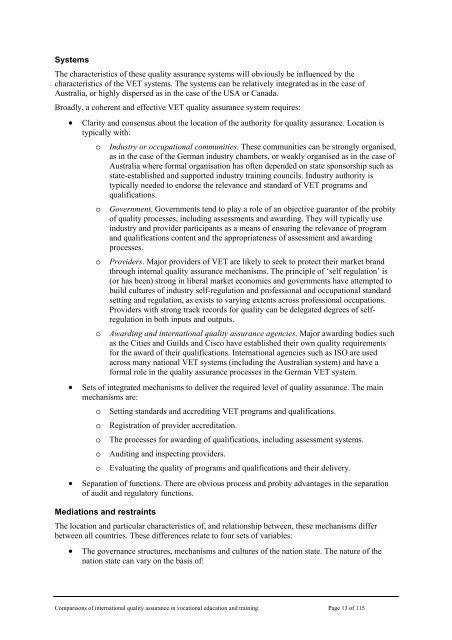Review - Department of Innovation, Industry, Science and Research
Review - Department of Innovation, Industry, Science and Research
Review - Department of Innovation, Industry, Science and Research
Create successful ePaper yourself
Turn your PDF publications into a flip-book with our unique Google optimized e-Paper software.
Systems<br />
The characteristics <strong>of</strong> these quality assurance systems will obviously be influenced by the<br />
characteristics <strong>of</strong> the VET systems. The systems can be relatively integrated as in the case <strong>of</strong><br />
Australia, or highly dispersed as in the case <strong>of</strong> the USA or Canada.<br />
Broadly, a coherent <strong>and</strong> effective VET quality assurance system requires:<br />
• Clarity <strong>and</strong> consensus about the location <strong>of</strong> the authority for quality assurance. Location is<br />
typically with:<br />
o<br />
o<br />
o<br />
o<br />
<strong>Industry</strong> or occupational communities. These communities can be strongly organised,<br />
as in the case <strong>of</strong> the German industry chambers, or weakly organised as in the case <strong>of</strong><br />
Australia where formal organisation has <strong>of</strong>ten depended on state sponsorship such as<br />
state-established <strong>and</strong> supported industry training councils. <strong>Industry</strong> authority is<br />
typically needed to endorse the relevance <strong>and</strong> st<strong>and</strong>ard <strong>of</strong> VET programs <strong>and</strong><br />
qualifications.<br />
Government. Governments tend to play a role <strong>of</strong> an objective guarantor <strong>of</strong> the probity<br />
<strong>of</strong> quality processes, including assessments <strong>and</strong> awarding. They will typically use<br />
industry <strong>and</strong> provider participants as a means <strong>of</strong> ensuring the relevance <strong>of</strong> program<br />
<strong>and</strong> qualifications content <strong>and</strong> the appropriateness <strong>of</strong> assessment <strong>and</strong> awarding<br />
processes.<br />
Providers. Major providers <strong>of</strong> VET are likely to seek to protect their market br<strong>and</strong><br />
through internal quality assurance mechanisms. The principle <strong>of</strong> ‘self regulation’ is<br />
(or has been) strong in liberal market economies <strong>and</strong> governments have attempted to<br />
build cultures <strong>of</strong> industry self-regulation <strong>and</strong> pr<strong>of</strong>essional <strong>and</strong> occupational st<strong>and</strong>ard<br />
setting <strong>and</strong> regulation, as exists to varying extents across pr<strong>of</strong>essional occupations.<br />
Providers with strong track records for quality can be delegated degrees <strong>of</strong> selfregulation<br />
in both inputs <strong>and</strong> outputs.<br />
Awarding <strong>and</strong> international quality assurance agencies. Major awarding bodies such<br />
as the Cities <strong>and</strong> Guilds <strong>and</strong> Cisco have established their own quality requirements<br />
for the award <strong>of</strong> their qualifications. International agencies such as ISO are used<br />
across many national VET systems (including the Australian system) <strong>and</strong> have a<br />
formal role in the quality assurance processes in the German VET system.<br />
• Sets <strong>of</strong> integrated mechanisms to deliver the required level <strong>of</strong> quality assurance. The main<br />
mechanisms are:<br />
o Setting st<strong>and</strong>ards <strong>and</strong> accrediting VET programs <strong>and</strong> qualifications.<br />
o Registration <strong>of</strong> provider accreditation.<br />
o The processes for awarding <strong>of</strong> qualifications, including assessment systems.<br />
o Auditing <strong>and</strong> inspecting providers.<br />
o Evaluating the quality <strong>of</strong> programs <strong>and</strong> qualifications <strong>and</strong> their delivery.<br />
• Separation <strong>of</strong> functions. There are obvious process <strong>and</strong> probity advantages in the separation<br />
<strong>of</strong> audit <strong>and</strong> regulatory functions.<br />
Mediations <strong>and</strong> restraints<br />
The location <strong>and</strong> particular characteristics <strong>of</strong>, <strong>and</strong> relationship between, these mechanisms differ<br />
between all countries. These differences relate to four sets <strong>of</strong> variables:<br />
• The governance structures, mechanisms <strong>and</strong> cultures <strong>of</strong> the nation state. The nature <strong>of</strong> the<br />
nation state can vary on the basis <strong>of</strong>:<br />
Comparisons <strong>of</strong> international quality assurance in vocational education <strong>and</strong> training Page 13 <strong>of</strong> 115
















